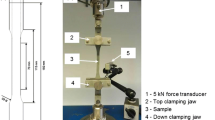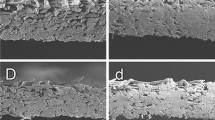The paper proposes a new approach to gradient porous composites based on the Ti3Al(Si)C2 MAX phase. This approach is based on the production of preceramic paper with the different content of the powder filler based on MAX phases and their spark plasma sintering. The analysis of the microstructure and phase composition is conducted for these composites. It is shown that the obtained composites have a clear interface between layers with different porosity. It is found that the content of organic components in preceramic paper affects the phase composition of the fabricated composites. The MAX phase content in dense and porous layers is 86 and 56 vol.%, respectively. Microhardness measurements performed in the composite cross-section show the hardness of 600 to 800 HV, depending on the layer porosity and phase composition.
Similar content being viewed by others
References
M. W. Barsoum, Prog. Solid State Chem., 28, No. 1–4, 201−281 (2000).
Z. Zhang, et al., J. Eur. Ceram. Soc., 41, No. 7, 3851−3878 (2021).
A. A. Smetkin and Yu. K. Maiorova, Vestnik Permskogo natsional'nogo issledovatel’skogo politekhnicheskogo universiteta. Mashinostroenie, materialovedenie, 17, No. 4 (2015).
A. Zhou, C. A. Wang, and Y. Hunag, J. Mater. Sci., 38, No. 14, 3111−3115 (2003).
S. N. Perevislov, I. E. Arlashkin, and A. S. Lysenkov, Refract. Ind. Ceram, 62, No. 4, 215–219 (2022).
X. Li, et al., Corros. Sci., 185, 109431 (2021).
N. Pal, et al., Mater. Today: Proceedings, 28, 1386−1391 (2020).
M. Duran and F. N. Tüzün, Int. J. Hydrog. Energy, 46, No. 57, 29216−2922 (2021).
C. Wang, et al., Carbon, 85, 445 (2015).
Z. Sun, et al., J. Am. Ceram. Soc., 93, No. 9, 2591−2597 (2010).
B. Velasco, E. Gordo, and S. A. Tsipas, J. Alloys Compd., 646, 1036−1042 (2015).
M. Potoczek, et al., J. Am. Ceram. Soc., 101, No. 12, 5346−5357 (2018).
C. R. Bowen and T. Thomas, Ceram. Int., 41, No. 9, 12178−12185 (2015).
A. A. Smetkin, V. G. Gilev, M. N. Kachenyuk, and D. S. Vokhmyanin, Refract. Ind. Ceram., 61, No. 1, 55–60 (2020).
S. A. Firstov, et al., Powder Metall. Met. Ceram., 49, No. 7, 414−423 (2010).
S. Baumann, W. A. Meulenberg, and H. P. Buchkremer, J. Eur. Ceram. Soc., 33, No. 7, 1251−1261 (2013).
B. Dermeik, et al., Adv. Eng. Mater., 21, No. 6, 1900180 (2019).
N. Travitzky, et al., J. Am. Ceram. Soc., 91, No. 11, 3477−3492 (2008).
E. B. Kashkarov, et al., Adv. Eng. Mater., 22, No. 6, 2000136 (2020).
D. G. Krotkevich, et al., Ceram. Int., 47, No. 9, 12221−12227 (2021).
E. B. Kashkarov, et al., J. Eur. Ceram. Soc., 42, No. 5, 2062–2072 (2022).
Y. R. Mingazova, et al., J. Phys.: Conf. Ser., 1989, 012031 (2021).
E. P. Sedanova, et al., J. Phys.: Conf. Ser., 1611, 012007 (2020).
C. Grove and D. A. Jerram, Comput. Geosci., 37, No. 11, 1850−1859 (2011).
S. Wo, et al., Int. J. Appl. Ceram. Technol., 16, No. 6, 2398−2408 (2019).
Y. C. Zhou, J. X. Chen, and J. Y. Wang, Acta Mater., 54, No. 5, 1317−1322 (2006).
W. B. Zhou, B. C. Mei, and J. Q. Zhu, Mater. Lett., 59, No. 12, 1547−1551 (2005).
Author information
Authors and Affiliations
Corresponding author
Additional information
Translated from Izvestiya Vysshikh Uchebnykh Zavedenii, Fizika, No. 12, pp. 132–138, December 2022
Rights and permissions
Springer Nature or its licensor (e.g. a society or other partner) holds exclusive rights to this article under a publishing agreement with the author(s) or other rightsholder(s); author self-archiving of the accepted manuscript version of this article is solely governed by the terms of such publishing agreement and applicable law.
About this article
Cite this article
Krotkevich, D.G., Kashkarov, E.B., Mingazova, Y.R. et al. Fabrication of Max Phase-Based Gradient Porous Materials from Preceramic Paper. Russ Phys J 65, 2186–2192 (2023). https://doi.org/10.1007/s11182-023-02888-2
Received:
Accepted:
Published:
Issue Date:
DOI: https://doi.org/10.1007/s11182-023-02888-2




